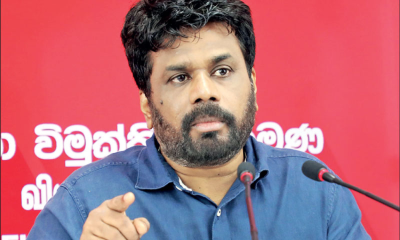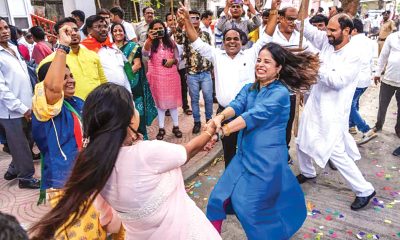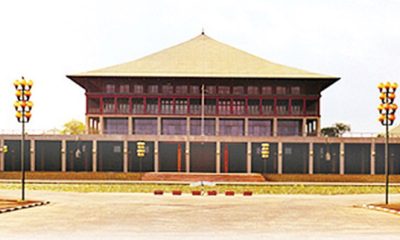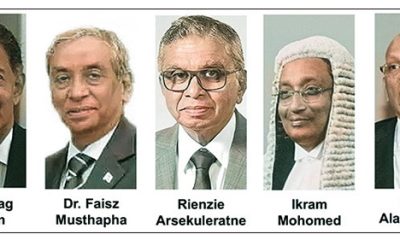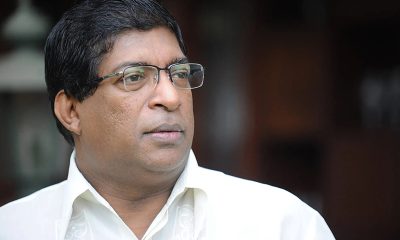Features
Divisions within SJB surface, Fonseka has hour-long meeting with Ranil
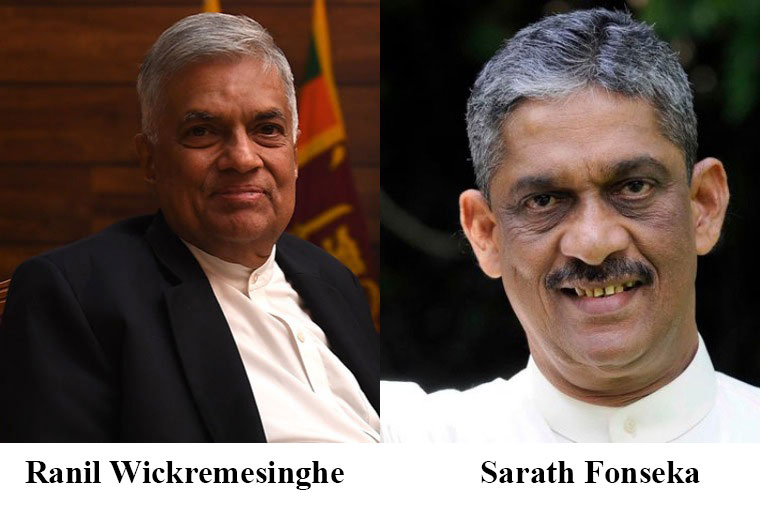
View from the gallery
by Saman Indrajith
President Ranil Wickremesinghe ceremonially commenced the fifth session of Parliament on Wednesday with a speech (once called the Throne Speech), calling on opposition parties to join his endeavor to rebuild the nation. It was his third policy speech in the legislature, the first and second being delivered on August 3, 2022, and February 8, 2023, commencing the third and fourth sessions of the ninth Parliament.
He directed that all ceremonial and events traditionally associated with the opening of Parliament be dispensed presumably for reasons of economy. So there was neither a military parade or 21-gun salute; only the reciting of Jayamangala Gatha by a bevy of pink-clad girls from Devi Balika Vidyalaya, Colombo.
The president called on the SJB and JVP to adapt and change for the sake of the nation’s welfare and the prosperity of the country’s youth and to share his vision to ‘unite in the pursuit of our nation-building dream.’
“In the interest of the nation’s welfare and the prosperity of our youth, the majority of the Podujana Peramuna have set aside past animosities and reached a consensus. Likewise, longstanding political allies have aligned with the Samagi Jana Balawegaya, including those whom I personally introduced to politics. If the Podujana Peramuna can unite for the greater good, why can’t the Samagi Jana Balawegaya follow suit?” the President asked.
Splits within the main opposition SJB were evident on Wednesday. Some of its members, led by Opposition Leader Premadasa, walked out as the president began speaking in accordance with a decision to boycott proceedings. But some of his MPs. Including party chairman Sarath Fonseka, Dr. Rajitha Senaratne, Champika Ranawaka, Kumara Welgama, Ishak Rahuman, Faizal Cassim, Vadivel Suresh and AHM Fowzie chose to remain. The TNA MPs were seen in their usual places, while the NPP’s Dr. Harini Amarasuriya was also present. Her her party colleagues were out of the country.
There was much talk in the lobbies and elsewhere about the divisions within the SJB. So also at the traditional tea party for MPs and guests hosted on these occasions. The president personally picked up the tab for the party, something unheard of in the past. He concluded his speech inviting everybody to tea and almost all MPs, parliament staff and members of the diplomatic corps present attended while some SJB MPs kept away.
At the party, Prime Minister Dinesh Gunawardena asked the president whether he noticed the apparent division within the SJB. A smiling president responded that there would be more to follow in the coming days. When the President said so, former President Mahinda Rajapaksa seated nearby was seen laughing loudly.
After the party, the president went up to his office on the second floor of the parliamentary complex. Among those awaiting him there was Field Marshal Sarath Fonseka. Others, including UNP seniors and some SJB MPs were also there but had to stay until the president, who took Fonseka into his office. finished his one-to-one hour-long conversation.
After Fonseka left, an SJB MP told the president that Premadasa had ordered all SJB MPs to boycott the speech and none to speak in Parliament on that day. Another MP raised the matter of JVP leader Anura Kumara Dissanayake leading an NPP delegation to India. The president said that India’s calling on Anura indicated that they have lost hope in the SJB and its leader. The usual protocol was that India would invite the opposition leader, he said. They didn’t do that as they no longer consider the SJB a force to reckon with.
Another MP said that the SJB leadership contacted the Indian High Commission and sought an invitation to India. Ashu Marasinghe said that the SJB is now divided into several groups. The party chairman does not respect the leader’s directives. Many SJB MPs were present in the chamber when the president delivered his speech. Some SJB MPs joined the president’s overseas visits with Kings Nelson joining the president on his visited Uganda while Gayantha Karunathilake attended the ceremony of the president giving land deeds to people. Some SJB MPs will join the president’s Australia visit too, Marasinghe claimed.
The president merely smiled when asked what the talks between him and Fonseka were all about. Vajira Abeywardena said Fonseka must surely must be upset about Premadasa bringing in former Army Commander Daya Ratnayake and ex-Navy Commander Daya Sandagiri into the SJB. “Daya Ratnayake does not have a vote base. Today’s youth do not recognize Sandagiri. They will not bring any new votes to the SJB,” Abeywardena said.
SLPP MP Madhura Withanage praised the President for his invitation to the SJB and NPP to join the government for the sake of the nation’s future. The SJB says that they boycott the session because their protest rally had been tear-gassed, he alleged.
“How many times did the SLPP MPs came under tear gas attacks during the Yahapalana government? How many of them had been arrested? But they set aside their differences to work for the sake of the country. With such examples, it is sad to note that the SJB equates the country’s future to a tear gas canister. On the other hand, it was I who saved President Ranasinghe Premadasa when there was an impeachment against him. If President Premadasa had lost the impeachment and gone home, then his son would not have had a chance to do politics today,” the president said.
On Thursday, a new MP was sworn in to fill the late Sanath Nishantha’s seat. Jagath Priyankara succeeded the late state minister in accordance with Puttalam district preference votes and took a seat in the opposition.
Although Thursday and Friday had been allotted to debate the president’s speech, many opposition MPs seized the opportunity to focus on the Online Safety Act passed the previous sitting week.
Opposition and SJB leader Premadasa raised concerns over the Online Safety Act, pointing out that nine clauses were not in line with the determination given by the Supreme Court.
During a heated exchange, Premadasa accused Speaker Abeywardena of violating the Constitution. Premadasa accused the government of ignoring the Supreme Court’s recommendations on several key clauses of the Online Safety Bill, including those pertaining to revoking internet access and addressing contempt of court. He highlighted the court’s emphasis on the need for due process and judicial oversight, both of which he claims are absent in the current legislation.
The speaker defended the process followed, saying that both sides needed to agree for a vote to be taken. He denied any personal interest in the amendments, claiming he merely “mentioned names.”Premadasa countered by criticizing the speaker’s refusal to call for votes on numerous occasions, calling it a dereliction of duty and a violation of the constitution.
Features
Beyond Left and Right: From Populism to Pragmatism and Recalibrating Democracy

The world is going through a political shake-up. Everywhere you look—from Western democracies to South Asian nations—people are choosing leaders and parties that seem to clash in ideology. One moment, a country swings left, voting for progressive policies and climate action. The next, a neighbouring country rushes into the arms of right-wing populism, talking about nationalism and tradition.
It’s not just puzzling—it’s historic. This global tug of war between opposing political ideas is unlike anything we’ve seen in recent decades. In this piece, I explore this wave of political contradictions, from the rise of labour movements in Australia and Canada, to the continued strength of conservative politics in the US and India, and finally to the surprising emergence of a radical leftist party in Sri Lanka.
Australia and Canada: A Comeback for Progressive Politics
Australia recently voted in the Labour Party, with Anthony Albanese becoming Prime Minister after years of conservative rule under Scott Morrison. Albanese brought with him promises of fairer wages, better healthcare, real action on climate change, and closing the inequality gap. For many Australians, it was a fresh start—a turn away from business-as usual politics.
In Canada, a political shift is unfolding with the rise of The Right Honourable Mark Carney, who became Prime Minister in March 2025, after leading the Liberal Party. Meanwhile, Jagmeet Singh and the New Democratic Party (NDP) are gaining traction with their progressive agenda, advocating for enhanced social safety nets in healthcare and housing to address growing frustrations with rising living costs and a strained healthcare system..
But let’s be clear—this isn’t a return to old-school socialism. Instead, voters seem to be leaning toward practical, social-democratic ideas—ones that offer government support without fully rejecting capitalism. People are simply fed up with policies that favour the rich while ignoring the struggles of everyday families. They’re calling for fairness, not radicalism.
America’s Rightward Drift: The Trump Effect Still Lingers
In contrast, the political story in the United States tells a very different tale. Even after Donald Trump left office in 2020, the Republican Party remains incredibly powerful—and popular.
Trump didn’t win hearts through traditional conservative ideas. Instead, he tapped into a raw frustration brewing among working-class Americans. He spoke about lost factory jobs, unfair trade deals, and an elite political class that seemed disconnected from ordinary life. His messages about “America First” and restoring national pride struck a chord—especially in regions hit hard by globalisation and automation.
Despite scandals and strong opposition, Trump’s brand of politics—nationalist, anti-immigration, and skeptical of global cooperation—continues to dominate the Republican Party. In fact, many voters still see him as someone who “tells it like it is,” even if they don’t agree with everything he says.
It’s a sign of a deeper trend: In the US, cultural identity and economic insecurity have merged, creating a political environment where conservative populism feels like the only answer to many.
India’s Strongman Politics: The Modi Era Continues
Half a world away, India is witnessing its own version of populism under Prime Minister Narendra Modi. His party—the Bharatiya Janata Party (BJP)—has ruled with a blend of Hindu nationalism, economic ambition, and strong leadership.
Modi is incredibly popular. His supporters praise his development projects, digital push, and efforts to raise India’s profile on the global stage. But critics argue that his leadership is dividing the country along religious lines and weakening its long-standing secular values.
Still, for many Indians—especially the younger generation and the rural poor—Modi represents hope, strength, and pride. They see him as someone who has delivered where previous leaders failed. Whether it’s building roads, providing gas connections to villages, or cleaning up bureaucracy, the BJP’s strong-arm tactics have resonated with large sections of the population.
India’s political direction shows how nationalism can be powerful—especially when combined with promises of economic progress and security.
A Marxist Comeback? Sri Lanka’s Political Wild Card
Then there’s Sri Lanka—a country in crisis, where politics have taken a shocking turn.
For decades, Sri Lanka was governed by familiar faces and powerful families. But after years of financial mismanagement, corruption, and a devastating economic collapse, public trust in mainstream parties has plummeted. Into this void stepped a party many thought had been sidelined for good—the Janatha Vimukthi Peramuna (JVP), a Marxist-Leninist group with a history of revolutionary roots.
Once seen as radical and even dangerous, the JVP has rebranded itself as a disciplined, modern political force. Today, it speaks directly to the country’s suffering masses: those without jobs, struggling to buy food, and fed up with elite corruption.
The party talks about fair wealth distribution, workers’ rights, and standing up to foreign economic pressures. While their ideas are left-leaning, their growing support is driven more by public frustration with current political leaders than by any shift toward Marxism by the public or any move away from it by the JVP.
Sri Lanka’s case is unique—but not isolated. Across the world, when economies collapse and inequality soars, people often turn to ideologies that offer hope and accountability—even if they once seemed extreme.
A Global Puzzle: Why Are Politics So Contradictory Now?
So what’s really going on? Why are some countries swinging left while others turn right?
The answer lies in the global crises and rapid changes of the past two decades. The 2008 financial crash, worsening inequality, mass migrations, terrorism fears, the COVID-19 pandemic, and now climate change have all shaken public trust in traditional politics.
Voters everywhere are asking the same questions: Who will protect my job? Who will fix healthcare? Who will keep us safe? The answers they choose depend not just on ideology, but on their unique national experiences and frustrations.
In countries where people feel abandoned by global capitalism, they may choose left-leaning parties that promise welfare and fairness. In others, where cultural values or national identity feel under threat, right-wing populism becomes the answer.
And then there’s the digital revolution. Social media has turbocharged political messaging. Platforms like Twitter, Facebook, and YouTube allow both left and right movements to reach people directly—bypassing traditional media. While this has given power to progressive youth movements, it’s also allowed misinformation and extremist views to flourish, deepening polarisation.
Singapore: The Legacy of Pragmatic Leadership and Technocratic Governance
Singapore stands as a unique case in the global political landscape, embodying a model of governance that blends authoritarian efficiency with capitalist pragmatism. The country’s political identity has been shaped largely by its founding Prime Minister, Lee Kuan Yew, often regarded as a political legend for transforming a resource-poor island into one of the most prosperous and stable nations in the world. His brand of leadership—marked by a strong central government, zero tolerance for corruption, and a focus on meritocracy—has continued to influence Singapore’s political ideology even after his passing. The ruling People’s Action Party (PAP), which has been in power since independence, remains dominant, but it has had to adapt to a new generation of voters demanding more openness, transparency, and participatory governance.
Despite criticisms of limited political pluralism, Singapore’s model is often admired for its long-term planning, public sector efficiency, and ability to balance rapid economic development with social harmony. In an era of rising populism and political fragmentation elsewhere, Singapore’s consistent technocratic approach provides a compelling counter-narrative—one that prioritises stability, strategic foresight, and national cohesion over ideological extremes.
What the Future Holds
We are living in a time where political boundaries are blurring, and old labels don’t always fit. Left and right are no longer clear-cut. Populists can be socialist or ultra-conservative. Liberals may support strong borders. Conservatives may promote welfare if it wins votes.
What matters now is trust—people are voting for those who seem to understand their pain, not just those with polished manifestos.
As economic instability continues and global challenges multiply, this ideological tug-of-war is likely to intensify. Whether we see more progressive reforms or stronger nationalist movements will depend on how well political leaders can address real issues, from food security to climate disasters.
One thing is clear: the global political wave is still rising. And it’s carrying countries in very different directions.
Conclusion
The current wave of global political ideology is defined by its contradictions, complexity, and context-specific transformations. While some nations are experiencing a resurgence of progressive, left-leaning movements—such as Australia’s Labour Party, Canada’s New Democratic Party, and Sri Lanka’s Marxist-rooted JVP—others are gravitating toward right-wing populism, nationalist narratives, and conservative ideologies, as seen in the continued strength of the US Republican Party and the dominant rule of Narendra Modi’s BJP in India. Amid this ideological tug-of-war, Singapore presents a unique political model. Eschewing populist swings, it has adhered to a technocratic, pragmatic form of governance rooted in the legacy of Lee Kuan Yew, whose leadership transformed a struggling post-colonial state into a globally admired economic powerhouse. Singapore’s emphasis on strategic planning, meritocracy, and incorruptibility provides a compelling contrast to the ideological turbulence in many democracies.
What ties these divergent trends together is a common undercurrent of discontent with traditional politics, growing inequality, and the digital revolution’s impact on public discourse. Voters across the world are searching for leaders and ideologies that promise clarity, security, and opportunity amid uncertainty. In mature democracies, this search has split into dual pathways—either toward progressive reform or nostalgic nationalism. In emerging economies, political shifts are even more fluid, influenced by economic distress, youth activism, and demands for institutional change.
Ultimately, the world is witnessing not a single ideological revolution, but a series of parallel recalibrations. These shifts do not point to the triumph of one ideology over another, but rather to the growing necessity for adaptive, responsive, and inclusive governance. Whether through leftist reforms, right-wing populism, or technocratic stability like Singapore’s, political systems will increasingly be judged not by their ideological purity but by their ability to address real-world challenges, unite diverse populations, and deliver tangible outcomes for citizens. In that respect, the global political wave is not simply a matter of left vs. right—it is a test of resilience, innovation, and leadership in a rapidly evolving world.
(The writer, a senior Chartered Accountant and professional banker, is Professor at SLIIT , Malabe. He is also the author of the “Doing Social Research and Publishing Results”, a Springer publication (Singapore), and “Samaja Gaveshakaya (in Sinhala). The views and opinions expressed in this article are solely those of the author and do not necessarily reflect the official policy or position of the institution he works for. He can be contacted at saliya.a@slit.lk and www.researcher.com)
Features
An opportunity to move from promises to results

The local government elections, long delayed and much anticipated, are shaping up to be a landmark political event. These elections were originally due in 2023, but were postponed by the previous government of President Ranil Wickremesinghe. The government of the day even defied a Supreme Court ruling mandating that elections be held without delay. They may have feared a defeat would erode that government’s already weak legitimacy, with the president having assumed office through a parliamentary vote rather than a direct electoral mandate following the mass protests that forced the previous president and his government to resign. The outcome of the local government elections that are taking place at present will be especially important to the NPP government as it is being accused by its critics of non-delivery of election promises.
Examples cited are failure to bring opposition leaders accused of large scale corruption and impunity to book, failure to bring a halt to corruption in government departments where corruption is known to be deep rooted, failure to find the culprits behind the Easter bombing and failure to repeal draconian laws such as the Prevention of Terrorism Act. In the former war zones of the north and east, there is also a feeling that the government is dragging its feet on resolving the problem of missing persons, those imprisoned without trial for long periods and return of land taken over by the military. But more recently, a new issue has entered the scene, with the government stating that a total of nearly 6000 acres of land in the northern province will be declared as state land if no claims regarding private ownership are received within three months.
The declaration on land to be taken over in three months is seen as an unsympathetic action by the government with an unrealistic time frame when the land in question has been held for over 30 years under military occupation and to which people had no access. Further the unclaimed land to be designated as “state land” raises questions about the motive of the circular. It has undermined the government’s election campaign in the North and East. High-level visits by the President, Prime Minister, and cabinet ministers to these regions during a local government campaign were unprecedented. This outreach has signalled both political intent and strategic calculation as a win here would confirm the government’s cross-ethnic appeal by offering a credible vision of inclusive development and reconciliation. It also aims to show the international community that Sri Lanka’s unity is not merely imposed from above but affirmed democratically from below.
Economic Incentives
In the North and East, the government faces resistance from Tamil nationalist parties. Many of these parties have taken a hardline position, urging voters not to support the ruling coalition under any circumstances. In some cases, they have gone so far as to encourage tactical voting for rival Tamil parties to block any ruling party gains. These parties argue that the government has failed to deliver on key issues, such as justice for missing persons, return of military-occupied land, release of long-term Tamil prisoners, and protection against Buddhist encroachment on historically Tamil and Muslim lands. They make the point that, while economic development is important, it cannot substitute for genuine political autonomy and self-determination. The failure of the government to resolve a land issue in the north, where a Buddhist temple has been put up on private land has been highlighted as reflecting the government’s deference to majority ethnic sentiment.
The problem for the Tamil political parties is that these same parties are themselves fractured, divided by personal rivalries and an inability to form a united front. They continue to base their appeal on Tamil nationalism, without offering concrete proposals for governance or development. This lack of unity and positive agenda may open the door for the ruling party to present itself as a credible alternative, particularly to younger and economically disenfranchised voters. Generational shifts are also at play. A younger electorate, less interested in the narratives of the past, may be more open to evaluating candidates based on performance, transparency, and opportunity—criteria that favour the ruling party’s approach. Its mayoral candidate for Jaffna is a highly regarded and young university academic with a planning background who has presented a five year plan for the development of Jaffna.
There is also a pragmatic calculation that voters may make, that electing ruling party candidates to local councils could result in greater access to state funds and faster infrastructure development. President Dissanayake has already stated that government support for local bodies will depend on their transparency and efficiency, an implicit suggestion that opposition-led councils may face greater scrutiny and funding delays. The president’s remarks that the government will find it more difficult to pass funds to local government authorities that are under opposition control has been heavily criticized by opposition parties as an unfair election ploy. But it would also cause voters to think twice before voting for the opposition.
Broader Vision
The government’s Marxist-oriented political ideology would tend to see reconciliation in terms of structural equity and economic justice. It will also not be focused on ethno-religious identity which is to be seen in its advocacy for a unified state where all citizens are treated equally. If the government wins in the North and East, it will strengthen its case that its approach to reconciliation grounded in equity rather than ethnicity has received a democratic endorsement. But this will not negate the need to address issues like land restitution and transitional justice issues of dealing with the past violations of human rights and truth-seeking, accountability, and reparations in regard to them. A victory would allow the government to act with greater confidence on these fronts, including possibly holding the long-postponed provincial council elections.
As the government is facing international pressure especially from India but also from the Western countries to hold the long postponed provincial council elections, a government victory at the local government elections may speed up the provincial council elections. The provincial councils were once seen as the pathway to greater autonomy; their restoration could help assuage Tamil concerns, especially if paired with initiating a broader dialogue on power-sharing mechanisms that do not rely solely on the 13th Amendment framework. The government will wish to capitalize on the winning momentum of the present. Past governments have either lacked the will, the legitimacy, or the coordination across government tiers to push through meaningful change.
Obtaining the good will of the international community, especially those countries with which Sri Lanka does a lot of economic trade and obtains aid, India and the EU being prominent amongst these, could make holding the provincial council elections without further delay a political imperative. If the government is successful at those elections as well, it will have control of all three tiers of government which would give it an unprecedented opportunity to use its 2/3 majority in parliament to change the laws and constitution to remake the country and deliver the system change that the people elected it to bring about. A strong performance will reaffirm the government’s mandate and enable it to move from promises to results, which it will need to do soon as mandates need to be worked at to be long lasting.
by Jehan Perera
Features
From Tank 590 to Tech Hub: Reunited Vietnam’s 50-Year Journey

 The fall of Saigon (now Ho Chi Minh City – HCM) on 30 April 1975 marked the end of Vietnam’s decades-long struggle for liberation—first against French colonialism, then U.S. imperialism. Ho Chi Minh’s Viet Minh, formed in 1941, fought Japanese occupiers and later defeated France at Dien Bien Phu (1954). The Geneva Accords temporarily split Vietnam, with U.S.-backed South Vietnam blocking reunification elections and reigniting conflict.
The fall of Saigon (now Ho Chi Minh City – HCM) on 30 April 1975 marked the end of Vietnam’s decades-long struggle for liberation—first against French colonialism, then U.S. imperialism. Ho Chi Minh’s Viet Minh, formed in 1941, fought Japanese occupiers and later defeated France at Dien Bien Phu (1954). The Geneva Accords temporarily split Vietnam, with U.S.-backed South Vietnam blocking reunification elections and reigniting conflict.
The National Liberation Front (NLF) led resistance in the South, using guerrilla tactics and civilian support to counter superior U.S. firepower. North Vietnam sustained the fight via the Ho Chi Minh Trail, despite heavy U.S. bombing. The costly 1968 Tet Offensive exposed U.S. vulnerabilities and shifted public opinion.
Of even more import, the Vietnam meat-grinder drained the U.S. military machine of weapons, ammunition and morale. By 1973, relentless resistance forced U.S. withdrawal. In March 1975, the Vietnamese People’s Army started operations in support of the NLF. The U.S.-backed forces collapsed, and by 30 April the Vietnamese forces forced their way into Saigon.
At 11 am, Soviet-made T-54 tank no. 843 of company commander Bui Quang Than rammed into a gatepost of the presidential palace (now Reunification Palace). The company political commissar, Vu Dang Toan, following close behind in his Chinese-made T-59 tank, no. 390, crashed through the gate and up to the palace. It seems fitting that the tanks which made this historic entry came from Vietnam’s principal backers.
Bui Quang Than bounded from his tank and raced onto the palace rooftop to hoist the NLF flag. Meanwhile, Vu Dang Toan escorted the last president of the U.S.-backed regime, Duong Van Minh, to a radio station to announce the surrender of his forces. This surrender meant the liberation not only of Saigon but also of the entire South, the reunification of the country, and a triumph of perseverance—a united, independent nation free from foreign domination after a 10,000-day war.
Celebrations
On 30 April 2025, Vietnam celebrated the 50th anniversary of the Liberation of the South and National Reunification. HCM sprouted hundreds of thousands of national flags and red hammer-and-sickle banners, complemented by hoardings embellished with reminders of the occasion – most of them featuring tank 590 crashing the gate.
Thousands of people camped on the streets from the morning of 29 April, hoping to secure good spots to watch the parade. Enthusiasm, especially of young people, expressed itself by the wide use of national flag t-shirts, ao dais (traditional long shirts over trousers), conical hats, and facial stickers. This passion may reflect increasing prosperity in this once impoverished land.
The end of the war found Vietnam one of the poorest countries in the world, with a low per capita income and widespread poverty. Its economy struggled due to a combination of factors, including wartime devastation, a lack of foreign investment and heavy reliance on subsistence agriculture, particularly rice farming, which limited its potential for growth. Western sanctions meant Vietnam relied heavily on the Soviet Union and its socialist allies for foreign trade and assistance.
The Vietnamese government launched Five-Year Plans in agriculture and industry to recover from the war and build a socialist nation. While encouraging family and collective economies, it restrained the capitalist economy. Despite these efforts, the economy remained underdeveloped, dominated by small-scale production, low labour productivity, and a lack of modern technology. Inflexible central planning, inept bureaucratic processes and corruption within the system led to inefficiencies, chronic shortages of goods, and limited economic growth. As a result, Vietnam’s economy faced stagnation and severe hyperinflation.
These mounting challenges prompted the Communist Party of Vietnam to introduce Đổi Mới (Renovation) reforms in 1986. These aimed to transition from a centrally planned economy to a “socialist-oriented market economy” to address inefficiencies and stimulate growth, encouraging private ownership, economic deregulation, and foreign investment.
Transformation
Đổi Mới marked a historic turning point, unleashing rapid growth in agricultural output, industrial expansion, and foreign direct investment. Early reforms shifted agriculture from collective to household-based production, encouraged private enterprise, and attracted foreign investment. In the 2000s, Vietnam became a top exporter of textiles, electronics, and rice, shifting towards high-tech manufacturing (inviting Samsung and Intel factories). By the 2020s, it emerged as a global manufacturing hub, the future focus including the digital economy, green energy, and artificial intelligence.
In less than four decades, Vietnam transformed from a poor, agrarian nation into one of Asia’s fastest-growing economies, though structural reforms are still needed for sustainable development. Growth has remained steady, at 5-8% per year.
Vietnam’s reforms lifted millions out of poverty, created a dynamic export-driven economy, and improved education, healthcare, and infrastructure. This has manifested itself in reducing extreme poverty from 70% to 1%, increasing literacy to 96%, life expectancy from 63 to 74 years, and rural electrification from less than 50% to 99.9%. Industrialisation drove urbanisation, which doubled from 20% in 1986 to 40% now.
This change displayed itself during the celebrations in HCM, amid skyscrapers, highways and the underground metro system. Everybody dressed well, and smartphones could be seen everywhere – penetration has reached three-fourths of the population. Thousands turned out on motorbikes and scooters (including indigenous electric scooters) – two-wheeler ownership is over 70%, the highest rate per capita in ASEAN. Traffic jams of mostly new cars emphasised the growth of the middle class.
At the same time, street food vendors and makeshift pavement bistro owners joined sellers of patriotic hats, flags and other paraphernalia to make a killing from the revellers. This reflects the continuance of the informal sector– currently representing 30% of the economy.
The Vietnamese government channelled tax income from booming sectors into underdeveloped regions, investing in rural infrastructure and social welfare to balance growth and mitigate urban-rural inequality during rapid economic expansion. Nevertheless, this economic transformation came with unequal benefits, exacerbating income inequality and persistent gender gaps in wages and opportunities. Sustaining growth requires tackling corruption, upgrading workforce skills, and balancing development with inequality.
NLF flag

Tank 390 courtesy Bao Hai Duong
The parade itself, meticulously carried out (having been rehearsed over three days), featured cultural pageants and military displays and drew admiration. Of special note, the inclusion of foreign military contingents from China, Laos, and Cambodia for the first time signalled greater regional solidarity, acknowledging their historical support while maintaining a balanced foreign policy approach.
Veteran, war-era foreign journalists noted another interesting fact: the re-emergence of the NLF flag. Comprising red and blue stripes with a central red star, this flag had never been prominent at the ten-year anniversary celebrations. The journalists questioned its sudden reappearance. It may be to give strength to the idea of the victory being one of the South itself, part of a drive to increase unity between North and South.
Before reunification in 1975, North and South Vietnam embodied starkly contrasting economic and social models. The North operated under a centrally planned socialist system, with collectivised farms and state-run industries. It emphasised egalitarianism, mass education, and universal healthcare while actively preserving traditional Vietnamese culture. The South, by contrast, maintained a market-oriented economy heavily reliant on agricultural exports (rice and rubber) and foreign aid. A wealthy elite dominated politics and commerce, while Western—particularly American—cultural influence grew pervasive during the war years.
Following reunification under the Socialist Republic of Vietnam (1976), the government moved swiftly to integrate the two regions. In 1978, it introduced a unified national currency (the đồng, VND), merging the North’s and South’s financial systems into a single, state-controlled framework. The unification of monetary policy symbolised the broader ideological project: to erase colonial and capitalist legacies.
Unity and solidarity
However, the economic disparities and cultural divides between regions persist, though less pronounced than before. The South, particularly HCM, remains Vietnam’s economic powerhouse, with a stronger private sector and international trade connections. The North, including Hanoi, has a more government-driven economy. Southerners tend to have a more entrepreneurial mindset, while Northerners are often seen as more traditional and rule-bound. Conversely, individuals from the North occupy more key government positions.
Studies suggest that people in the South exhibit lower trust in the government compared to those in the North. HCM tends to have stronger support for Western countries like the United States, while Hanoi has historically maintained closer ties with China. People in HCM tend to use the old “Saigon” city name.
Consequently, the 50th anniversary celebrations saw a focus on reconciliation and unity, reflecting a shift in perspective towards peace and friendship, as well as accompanying patriotism with international solidarity.
The exuberant crowds, modern infrastructure, and thriving consumer economy showcased the transformative impact of Đổi Mới—yet lingering regional disparities, informal labour challenges, and unequal gains remind the nation that sustained progress demands inclusive reforms. The symbolic return of the NLF flag and the emphasis on unity underscored a nuanced reconciliation between North and South, honouring shared struggle while navigating enduring differences.
As Vietnam strides forward as a rising Asian economy, it balances its socialist legacy with global ambition, forging a path where prosperity and patriotism converge. The anniversary was not just a celebration of the past but a reflection on the complexities of Vietnam’s ongoing evolution.
(Vinod Moonesinghe read mechanical engineering at the University of Westminster, and worked in Sri Lanka in the tea machinery and motor spares industries, as well as the railways. He later turned to journalism and writing history. He served as chair of the Board of Governors of the Ceylon German Technical Training Institute. He is a convenor of the Asia Progress Forum, which can be contacted at asiaprogressforum@gmail.com.)
By Vinod Moonesinghe
-

 Sports7 days ago
Sports7 days agoOTRFU Beach Tag Rugby Carnival on 24th May at Port City Colombo
-

 News5 days ago
News5 days agoRanil’s Chief Security Officer transferred to KKS
-

 Opinion3 days ago
Opinion3 days agoRemembering Dr. Samuel Mathew: A Heart that Healed Countless Lives
-

 Business1 day ago
Business1 day agoAitken Spence Travels continues its leadership as the only Travelife-Certified DMC in Sri Lanka
-

 Features6 days ago
Features6 days agoThe Broken Promise of the Lankan Cinema: Asoka & Swarna’s Thrilling-Melodrama – Part IV
-

 News6 days ago
News6 days agoRadisson Blu Hotel, Galadari Colombo appoints Marko Janssen as General Manager
-

 Business5 days ago
Business5 days agoCCPI in April 2025 signals a further easing of deflationary conditions
-

 Features6 days ago
Features6 days agoA piece of home at Sri Lankan Musical Night in Dubai



